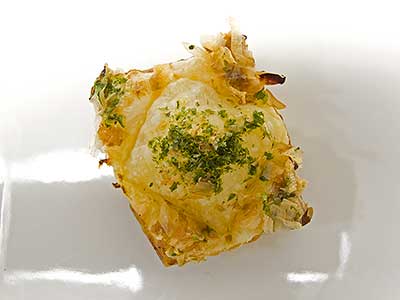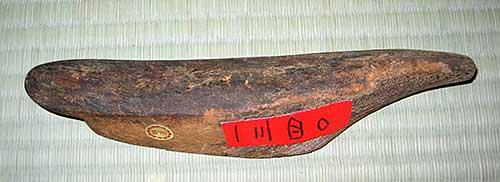August 18, 2014
Amuse-Bouche

bouffées de thon et algues
(tuna puffs)
For me, as a typical west-coast, middle-class kid, the iconic dish in the 1950s was a tuna casserole prepared from a can of tuna, a can of condensed cream of mushroom soup diluted with milk, and a 12-ounce package of egg noodles. Before baking, the casserole was topped with crumbled potato chips. Overall, it was pretty good. I even made it as a young adult, although I haven’t had it for maybe thirty or more years. According to an article from the 1990s, the first recipe for what my generation would recognize as tuna casserole was by Irma Rombauer. The recipe appeared in her unsuccessful sequel to The Joy of Cooking called Streamlined Cooking: New and Delightful Recipes For Canned, Packaged and Frosted Foods and Rapid Recipes For Fresh Foods. (Maybe the title was too long to be sellable?)
For my wife growing up at the same time in a large, working-class family of Okinawan ancestry on a sugar cane plantation on Maui, the can of tuna was cooked in soy sauce and mixed with white rice. There was no printed recipe. It was just a dish that her mom made to add flavor to rice without spending much money.
My wife also tells a story of when she was a little girl she thought her mother was feeding the family wood shavings. Her mother would take what looked like wood and rub it back and force over the top of a wooden box. When the drawer in the box was pulled out, it revealed a bunch of fine shavings. What my wife thought was wood as a little girl was a piece of highly dried “tuna.” Specifically, the dried tuna was bonito. Although not technically tuna, bonito is often labeled as such. Bonito is in the same family as tuna, but so is mackerel, which is also not tuna.

The Japanese call bonito katsuobushi (かつおぶし). Today, it is more commonly available as shavings. (I may be the only person on my block with a katsuobushi kezuriki, the plane used to shave the dried bonito, although I never use it.) The packaged katsuobushi is available in two sizes: smaller, thinner shavings, called hanakatsuo (はなかつお) and larger, thicker shavings, called kezurikatsuo (けずりかつお). Both sizes are regular staples in my pantry.
I regularly use the hanakatsuo as a topping on okonomiyaki, or on my faux version. Other common toppings that are also on hand are aonori and okonomi sauce. So when I was looking for unusual flavorings to encapsulate in puff pastry, these all came to mind.
1, 13x13 cm (5x5 in) piece
puff pastry
small katsuobushi flakes
aonori flakes
okonomi sauce
1. Roll out the pastry until it is 18 cm (7-1⁄8 in) square. Mark and cut a three-by-three pattern of 6 cm (2-3⁄8 in) squares in the puff pastry.
2. With a small, barely wet brush, brush about a 1⁄2 cm (3⁄8 in) border of each small square with water.
3. Using angled-tip tweezers, place a tweezer-full portion of katsuobushi in the center of each little square. Do the same with the aonori.
4. Working with one small square at a time, fold the corners of the square together forming a smaller square. Use the sides of the tweezer tips to pinch the seams of the dough together at the corners. Place the squares on a floured plate and freeze.
5. To serve, preheat oven to 180 °C (355 °F).
6. Lightly brush the tops of the frozen squares with okonomi sauce. Arrange the squares on a silicone mat set on a baking sheet. Bake for 15 minutes.
7. Cool slightly before serving.
Yield: 9 servings.
© 2014 Peter Hertzmann. All rights reserved.
